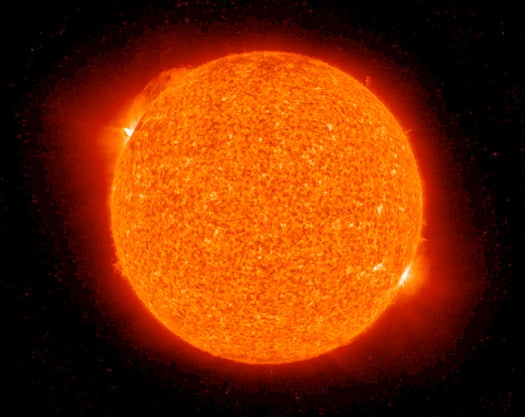On Tuesday, the biggest solar flare in four years erupted from the sun, sending a mass of charged particles hurtling towards Earth. NASA announced that it was an M-2 (medium-sized) flare and an S1-class (minor) radiation storm. The electromagnetic pulse it induced created amazing auroras, but it could also damage satellites and radio communications. What would happen with an even stronger, larger flare? Something terrible…
And click here to see the amazing video of this week’s massive solar belch.
Before the Impact: Coronal Mass Ejection
Ejection The sun regularly releases bubbles of gas particles called coronal mass ejections. Many CMEs hurtle harmlessly through space, but about 30 collide with Earth every year, many glancing off its atmosphere. A direct hit from a very large CME is a one-in-100-year event. In Transit CMEs travel at up to six million miles per hour and can reach Earth in as little as 18 hours. As they move through space, CMEs produce shock waves that can damage satellites, and their high-energy proton radiation increases astronauts’ risk of cancer. Collision How the CME strikes the planet’s electromagnetic shield determines how disastrous the storm will be. If its magnetic field is parallel with the Earth’s, the planet’s shield will replace repel it. But if its magnetic field is aligned opposite the Earth’s, the two magnetic fields connect, which allows the CME’s charged particles to enter the atmosphere.
After Impact: The Surge
Charged particles create ground currents by magnetic induction–the same process occurs when a magnet is near a loop of wire and generates an electrical current in the wire. This then causes a surge through power lines that can melt the copper component inside transformers. Such a surge in the U.S. could leave 130 million people without power.
Defense Systems
STEREO The Solar Terrestrial Relations Observatory [pictured] monitors the sun with two satellites on opposite sides of the star. Together they capture complete images of its surface, including CMEs. Warning Time: 24-48 hours SOHO The Solar and Heliospheric Observatory combines its findings with STEREO’s images to create a 3-D model, which helps predict when a CME might strike, plus or minus seven hours. Warning Time: 24-48 hours ACE Launched in 1997, the Advanced Composition Explorer will eventually transmit measurements of CMEs to anticipate electrical surges and their impact on the grid. Warning Time: 1 hour
Defense Systems That Won’t Warn Us
SDO NASA’s Solar Dynamics Observatory spacecraft [pictured] was launched last year to monitor the sun’s magnetic fields and gather data to determine how space weather is created. No warning time. CSWL With its gamma-ray-burst detector and 3-D plasma analyzer, the Comprehensive Solar Wind Laboratory aids predictions of how Earth-bound CMEs might affect the planet’s magnetic field. No warning time.
Prevention
Transformer Replacement Conventional transformers take years to manufacture and can weigh 100 tons. The Homeland Security-funded Recovery Transformer project, or RecX, is developing a temporary transformer that can be easily stored, moved on flatbed trucks, and installed within a few days during an emergency. Ultimately, the RecX team intends to build solid-state transformers that are smaller and lighter and can be moved by helicopter. Surge Protection The Neutral Capacitor and Bypass Device, developed by independent electrical engineer John Kappenman, uses a simple capacitor to block space-storm-induced DC currents from surging through transformers. It also includes a rapid-bypass circuit (or vacuum tube) for a path to the ground for normal AC-current problems caused by storms, tree limbs or errant birds. Kappenman estimates that protecting the country’s entire grid from a massive CME would require 5,000 of his devices.
The Possible Fallout
Lights A 1989 solar storm brought down Quebec’s power grid, leaving millions in the dark for nine hours. A larger storm will affect hundreds of millions of people. Traffic signals not equipped with backup battery power (most of New York City’s) would also fail immediately. Transportation Without power, gas pumps don’t work. Trains won’t run either: During the 2003 Northeast blackout, 400,000 commuters were stranded in the New York City subway system. Communication Surges knock out landlines and cellular networks. Both have backup systems that run for just a few days at most.
More Fallout: No Medicine, No Water
Medicine With transportation systems down, hospital generators run out of fuel after a few weeks, or even days. Ventilators and heart and lung pumps will no longer work. Drugs that need refrigeration will soon spoil. Insulin goes bad after 28 days. Water Pumps Municipal pumps fail, causing backflow–water runs backward through pipes and gets contaminated with bacteria. Water pumps shut off in residential homes and apartments, leaving millions without potable water. Cities issue boiling advisories, but most stoves can’t work without power or natural gas. After a month running backup diesel and batteries, nuclear plants’ water pumps for cooling pools stop. Spent fuel rods melt down, and radiation can escape into the air.







